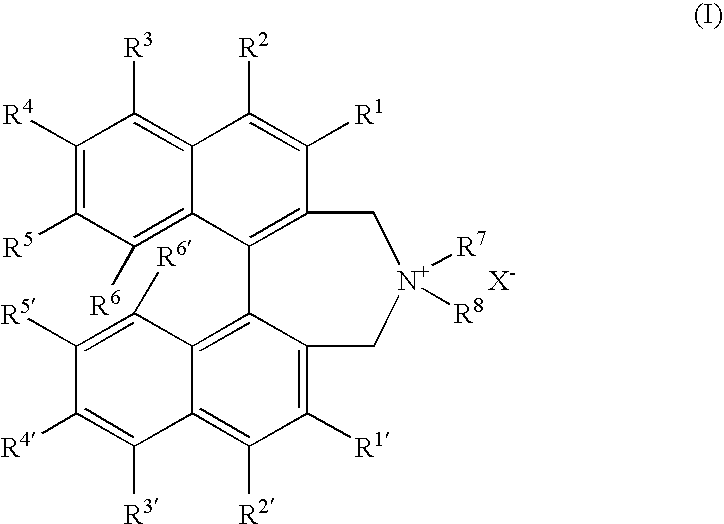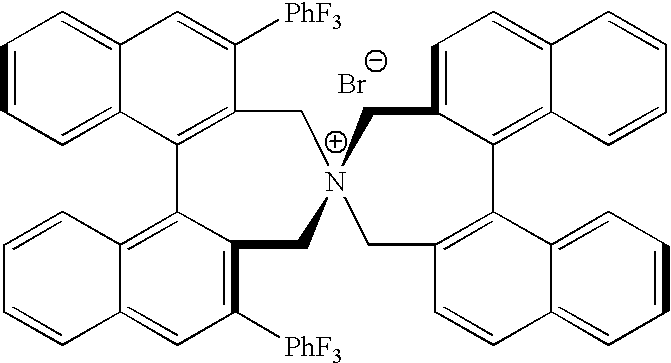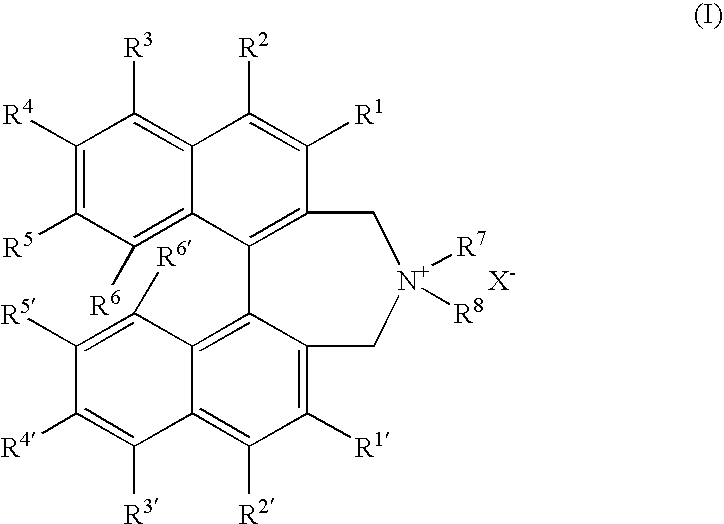OPTICALLY ACTIVE QUATERNARY AMMONIUM SALT HAVING AXIAL ASYMMETRY AND PROCESS FOR PRODUCING alpha-AMINO ACID AND DERIVATIVE THEREOF WITH THE SAME
a technology of axial asymmetry and quaternary ammonium salt, which is applied in the direction of organic compounds/hydrides/coordination complexes, organic chemistry, physical/chemical process catalysts, etc., can solve the problems of time and labor, no effective method for preparing the same, and the chiral phase-transfer catalyst derived from such cinchona alkaloid is not very useful, etc., to achieve the effect of simplifying the structur
- Summary
- Abstract
- Description
- Claims
- Application Information
AI Technical Summary
Benefits of technology
Problems solved by technology
Method used
Image
Examples
reference example 1
Synthesis of Starting Material (Compound 6) for Synthesizing Quaternary Ammonium Salt
[1637]
[1638] A compound 1 (S-form), isopropyl bromide in 10 equivalents with respect to the compound 1, 20 mol % of a catalyst Bu4N.HSO4, and 10 equivalents of potassium fluoride dihydrate were allowed to react for 24 hours under reflex in tetrahydrofuran to give a compound 2 in a 95% yield. Then, 4 equivalents of Mg(TMP)2 that was newly prepared in tetrahydrofuran was added dropwise to the compound 2 at 0° C., and subsequently 8 equivalents of bromine was added dropwise at −78° C. Thereafter, the reaction mixture was stirred at room temperature for one hour to give a compound 3 in a 91% yield. The compound 3 and 2.4 equivalents of 3,4,5-trifluorophenyl boronic acid were subjected to the Suzuki-Miyaura cross-coupling reaction in the presence of 5 mol % of palladium acetate, 15 mol % of PPh3 and 3 equivalents of potassium carbonate in dimethylformamide at 90° C. for 8 hours to give a compound 4 in a...
example 1
Synthesis of Quaternary Ammonium Salt (Compound 7)
[1639]
[1640] A mixture of the compound 6 (S-form) (280 mg, 0.4 mmol), dibutylamine (140 μL, 0.8 mmol), and potassium carbonate (82 mg, 0.6 mmol) in acetonitrile (5 mL) was heated and refluxed for 10 hours with stirring. The mixture was poured into water and extracted with dichloromethane. The organic layer extract was dried over sodium sulfate, and concentrated. The residue was purified by silica gel column chromatography (eluent:methanol / dichloromethane=1:20) for purification to give a compound 7 (S-form) (247 mg, 0.33 mmol) in a 83% yield.
[1641] The NMR spectrum of the obtained compound 7 (S-form) was as follows: 1H NMR (400 MHz, CDCl3) δ 7.97-7.95 (4H, m, Ar—H), 7.55-7.51 (2H, m, Ar—H), 7.27-7.23 (8H m, Ar—H), 4.99 (2H, d, J=14.2 Hz, Ar—CH2), 3.74 (2H, d, J=13.9 Hz, Ar—CH2), 3.32 (2H, t, J=12.5 Hz, N—CH2—CH2), 2.56 (2H, t, J=12.3 Hz, N—CH2—CH2), 1.06-0.97 (6H, m, CH2), 0.71 (6H, t, J=6.9 Hz, CH3), 0.23 (2H, bs, CH2); 13C NMR (10...
example 2
Confirmation of α-benzylation of Alanine
[1643]
[1644] To a mixture of alanine (t)-butyl ester-p-chlorobenzyl Schiff base (compound 8) (134 mg, 0.5 mmol), 1 mol % of the compound 7 (S-form), and benzyl bromide (1.2 equivalents) in 2 mL of toluene, cesium hydroxide monohydrate (5 equivalents) was added at 0° C., and stirred under an argon atmosphere at 0° C. for 3 hours. The reaction mixture was poured into water and extracted with dichloromethane, and the solvent was removed, and then the residue was dissolved in 5 mL of tetrahydrofuran. Then, 5 mL of 0.5 M citric acid aqueous solution was added thereto and the mixture was stirred at room temperature for one hour. The aqueous layer was washed with ether and alkalized with sodium hydrogencarbonate, and then was extracted with dichloromethane. The organic layer was dried over sodium sulfate and concentrated to give an oily product. The obtained oily product was subjected to silica gel column chromatography (eluent:ethyl acetate / hexane=...
PUM
| Property | Measurement | Unit |
|---|---|---|
| Temperature | aaaaa | aaaaa |
| Fraction | aaaaa | aaaaa |
| Fraction | aaaaa | aaaaa |
Abstract
Description
Claims
Application Information
 Login to View More
Login to View More - R&D
- Intellectual Property
- Life Sciences
- Materials
- Tech Scout
- Unparalleled Data Quality
- Higher Quality Content
- 60% Fewer Hallucinations
Browse by: Latest US Patents, China's latest patents, Technical Efficacy Thesaurus, Application Domain, Technology Topic, Popular Technical Reports.
© 2025 PatSnap. All rights reserved.Legal|Privacy policy|Modern Slavery Act Transparency Statement|Sitemap|About US| Contact US: help@patsnap.com



